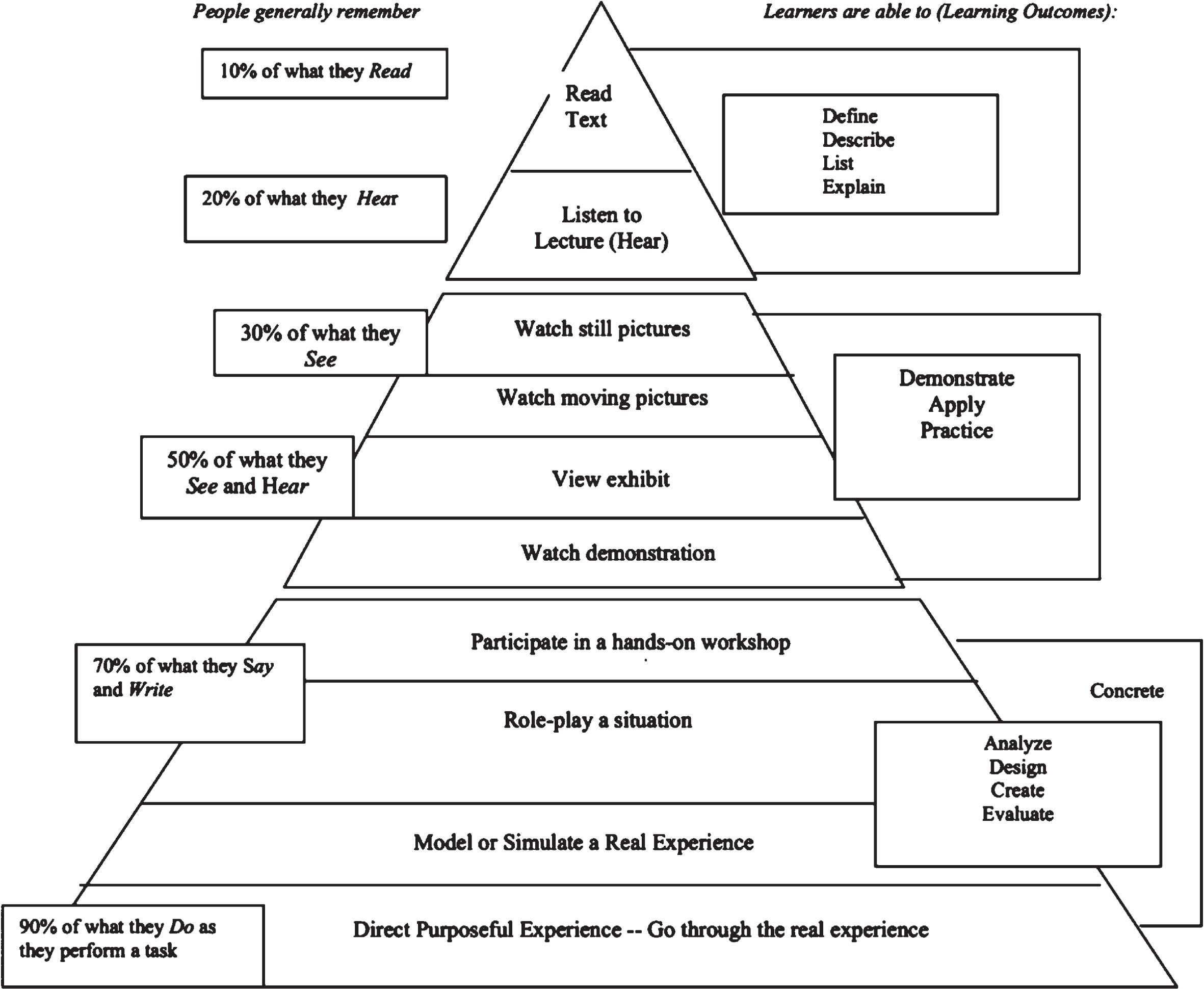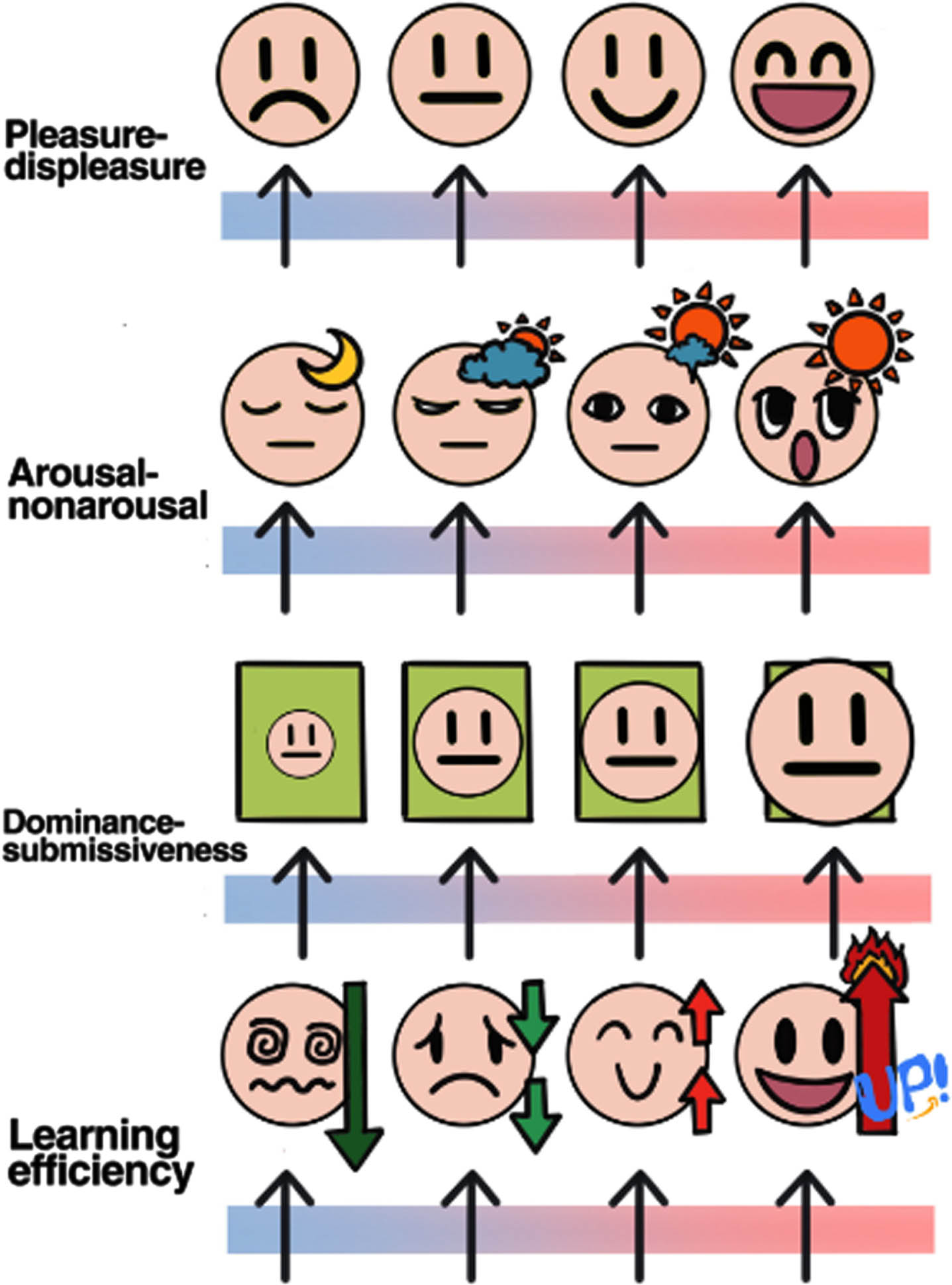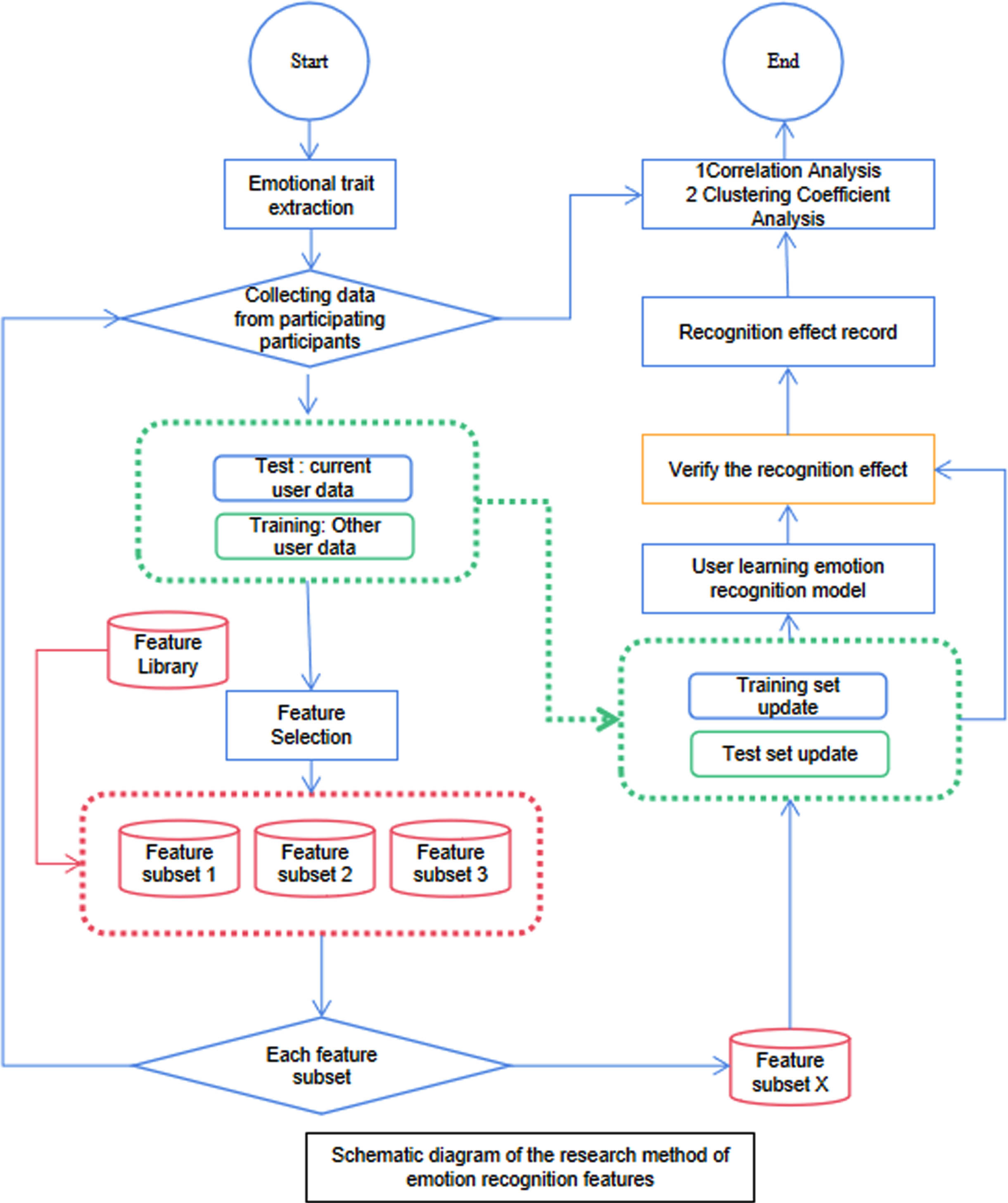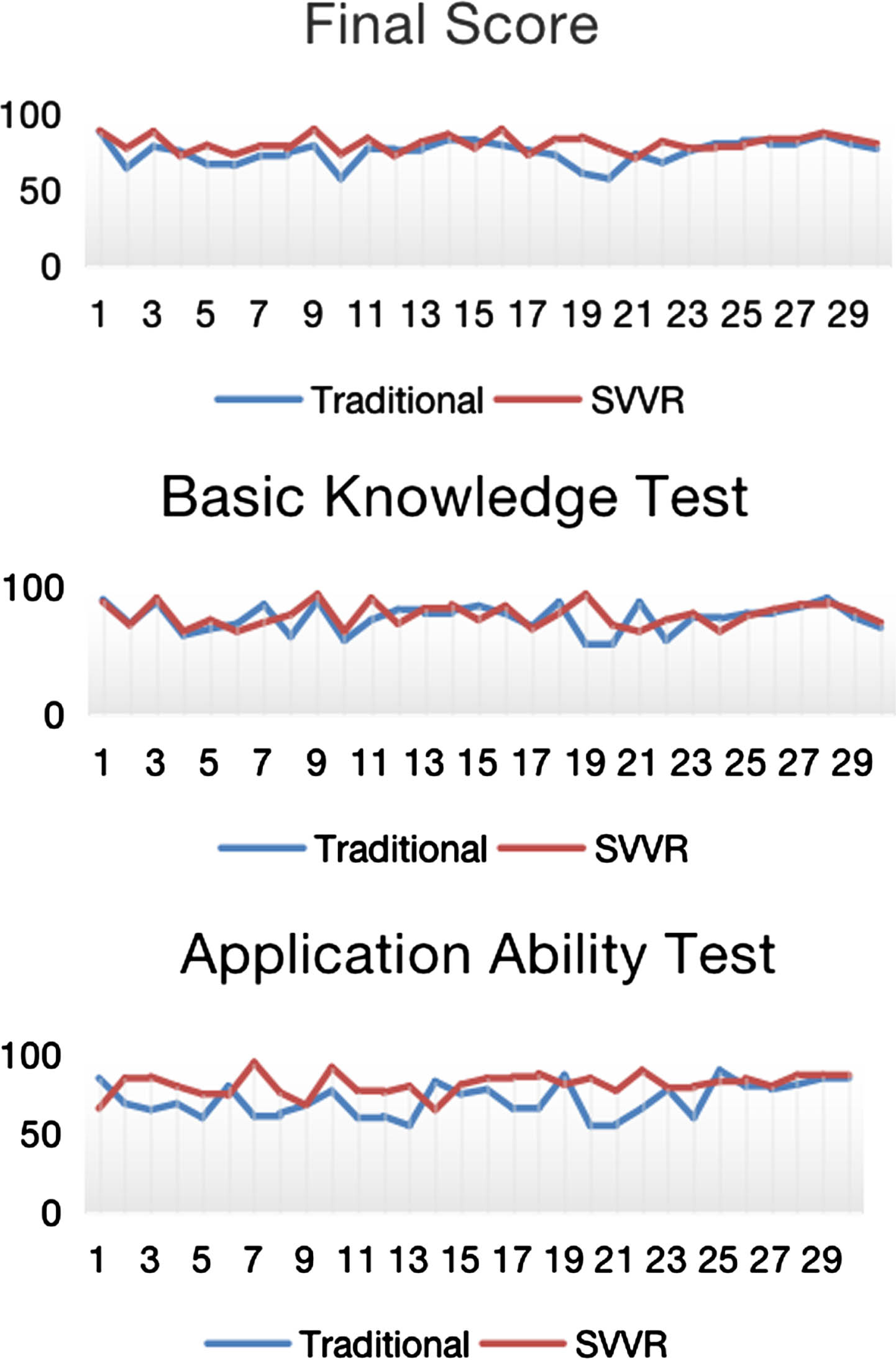The intercultural communication competence improvement for pre-service CSL teachers: A blended learning method based on SVVR
Abstract
BACKGROUND:
With the growing global influence of new coronary pneumonia and an increasing number of successful education case, spherical video-based virtual reality (SVVR) has arisen as an application for effective integration with teaching and learning.
OBJECTIVE:
This is a mixed-methods study on SVVR-based training for pre-service CSL teachers to more effectively develop their cross-cultural communication and interaction abilities.
METHODS:
An experimental strategy was adopted in this work. First, the processing of VR technology for designed TVET courses, including practical training courses, had been completed; The second experiment was a group experiment of one month; Finally, the hypotheses were tested by an independent sample t-test.
RESULTS:
Based on experiment data of the learners, this study build a multi-modal hybrid training and recognition model and confirm hybrid approach effectively improves the intercultural communication abilities of pre-service CSL teachers.
CONCLUSIONS:
The findings of this study confirm that information technology plays an important role in pre-service CSL teacher training, and teachers should incorporate more information technology, design more hands-on interactive activities and scenarios, and take into account the individual differences of learners in the teaching process. Several policy proposals are offered to ensure that ICT is better integrated into classroom instruction.

Yan Zhang: She is a lecture at the School of Preschool Education, Yunnan Normal University.Her research interests focus on the professional development of teachers.

De Xu: He is a professor at Jiangsu Development University, and dedicated to the research of collaborative innovation of smart construction and blockchain.

Tianyu Wang: She is a professor at the School of International Chinese Language Education, Yunnan Normal University, and is engaged in research on international Chinese language teaching and international Chinese teacher development.

Kewei Yang: He is PhD at Henan Pingdingshan Expressway Investment Co., Ltd, and dedicated to the research of management science and artificial intelligence.

Xinyifeng Yao: He is MBA, Chairman of Shenzhen Jieer Culture Communication Co., LTD, and committed to studying the promotion of traditional culture and the cultivation of students’ quality.

Mingshuang Cheng: She obtained her master’s degree in English Language and Literature from Northwest University. She is a doctoral candidate in Management at Siam University, Thailand. She is also the chief director in student affair management office in Finance School of Shandong Business and Technology University and is currently devoted to the study of educational management methods.

Dong Ge obtained his master’s degree in engineering from Beijing University of Posts and Telecommunications. He is a doctoral candidate in education at Siam University, Thailand. He used to be a senior software engineer and system architect, and is currently engaged in research on educational information technology.
1Introduction
It is undeniable that, in order to train future excellent foreign language teachers, appropriate cultural exchange and integration of intercultural communicative learning must take place in pre-service training programs, in addition to effective teaching of language pedagogy [1–3]. Countries such as Vietnam [4], Tunisia [5], and Morocco [6] have made similar efforts in pre-service EFL (English as Foreign Language) teacher education and see these initiatives as critical components of their respective pedagogical reforms.
In general, intercultural communicative competence training for pre-service EFL teachers has been integrated into the relevant curriculum and has used traditional teaching methods such as classroom simulation and practice teaching [7], microgrid teaching [8], flipped classroom [9], classroom observation, and reflection [10]. However, the global situation has changed dramatically due to the impact of the new crown epidemic in the past three years, with intense discussions and unprecedented innovations in all walks of life [11–14]. Together with the increasing digital transformation of education, information technology has been used more often in developing intercultural communication skills of pre-service foreign language teachers. As early as 2001, Abdelilah Salim Sehlaoui pointed out that CALL (Computer-Assisted Language Learning) has the potential to create connections between EFL teachers and communities, providing opportunities for the development and use of intercultural communicative competence [15]. Recent studies have also demonstrated that with the use of VE (Virtual Exchange), groups of learners can not only engage on collaborative projects with partners from another culture or geographical region, but also develop both digital and intercultural skills [16]. These studies looked into new ideas and methods for developing and improving intercultural communicative competence.
The number of Chinese language learners worldwide has increased rapidly in recent years. According to relevant statistics, more than 180 countries and regions worldwide will have offered Chinese language courses by the end of 2020, with 64 overseas countries incorporating Chinese into their national education systems [17]. Since 2021, Chinese has been the official language of the United Nations World Tourism Organization, and more than 20 million people in countries and regions other than China are learning the language (The Ministry of Education of the People’s Republic of China, 2021) [18]. Because of the rapid increase in Chinese language learners, an increasing number of students are engaging in cross-cultural communication interactions with teachers, and there is a pressing need for CSL (Chinese as a Second Language) teachers to be competent in cross-cultural communication. However, only a few studies have revealed that international Chinese teachers generally have poor intercultural communicative competence and a learning style that is primarily mechanical memorization [19–22], and it is still a topic that requires further research on how to improve the intercultural communicative competence of pre-service CSL teachers effectively.
2Literature review
2.1Training methods of pre-service foreign language teachers’ intercultural communication competence
Scholars agree that intercultural communicative competence should be integrated into the curriculum content of pre-service training for foreign language teachers [23–25], and most of them use traditional teaching methods to improve the professional skills and intercultural communication competence of foreign language teachers. However, as Hoa and Thi [26] point out, because intercultural competence has its own dimensions and developmental framework, it necessitates a distinct intercultural language learning and teaching (IcLLT) approach. It means that learners should actively participate in social interaction and critical reflection during the five steps of “construction,” “connection,” “reflection,” “interaction,” and “extension.” According to Benattabou (2020), the effective implementation of “critical incident” exercises, as well as the use of role-play and audiovisual media tools, can raise learners’ awareness of the potential risks associated with cross-cultural encounters [27].
In the study of intercultural communication competency training approaches for pre-service CSL teachers, Peng (2013) proposes an interactive pedagogy in the classroom between international students and pre-service CSL teachers [28]. Zheng and Li [29] propose a reflective intercultural teaching model that encourages students to actively explore various cultural phenomena and use archival portfolios to record the process of cultural research conducted by students, which can significantly enhance intercultural communication competence at the affective and behavioral levels [29]. Unfortunately, the majority of the teaching styles presented in these few studies are focused on offline classrooms, and more research on how to assist CSL teachers in improving the effectiveness of intercultural communication competence is still needed.
2.2ICT application in pre-service foreign language teacher training
Recently, governments all around the world have stepped up preparations and actions in response to the New Coronary Pneumonia epidemic [30], and social media use has significantly impacted people’s mental health [31]. It is increasingly noteworthy that this apparent trend towards IT integration is also present in the training of pre-service ESL teachers. Technologies such as web-based virtual communication and simulation experiences [32], ICT-supported audio training sessions [33], and the use of MICT (Mobile Information and Communication Technology) technology [34] have proven effective for preservice teacher training, and MALL (Mobile-Assisted Language Learning) training has even positively impacted preservice teachers’ cognition and used [35]. The traditional C-BL (Computer-Blended Learning) model, on the other hand, primarily presents instructional content through online videos and offline courses. Most students find it challenging to experience the real-world scenarios faced during professional training in such a one-sided information transmission and unproven learning environment, which impairs their judgment and actual processing performance [36].
There has not been much research on pre-service CSL teacher preparation that incorporates technology. Although the CoCAR (Cooperation-based cognition, action, and reflection) approach, which emphasizes cognition, action, and reflection, is seen to be suitable for developing pre-service CSL teachers’ online synchronous teaching skills, and can be used to enhance instructors’ ICT proficiency in general training programs [37]. However, Lin et al. (2014) discovered that a significant hurdle for pre-service CSL teachers is a lack of time to create technology-driven pedagogies and activities for ICT uptake [38]. On the other hand, recent related research has demonstrated that using intelligent teaching tools like Moso Teach (MT) and Rain Classroom (RC) (a new smart teaching tool that combines WeChat and other social media platforms) to develop instructional design techniques can improve the intercultural communication competency of preservice CSL instructors [39].
Although prior research on the development of foreign language teachers’ intercultural communicative skills, with English teachers as the core group, and its integration with information technology, has produced considerable outcomes; However, the research on the pre-service CSL teachers still receives little attention.
2.3SVVR application in pre-service foreign language teacher training
Among the different types of ICT technology applications, Spherical Video-based Virtual Reality (SVVR) has the advantage of providing highly immersive and highly interactive learning environments that can compensate for the shortcomings of other information technologies. It has been shown that its application in teaching practice offers new possibilities for the development of students’ problem-solving skills, provides richer contexts for students, and makes the learning process more interesting and interactive [40]; and it is an information technology that can facilitate effective learning for a wide range of learner types and ages [41–44]. According to some studies, SVVR, because of its ability to help learners experience being more immersed in authentic socio-cultural environments and English language practice environments, has had a more positive effect on learners’ spoken English, motivation, and critical thinking skills, and has helped to reduce their English language learning anxiety, and this technology has proven to be effective in improving the oral performance of EFL teachers [45] and the perception of learning in terms of being effective [46]. Moreover, SVVR training using dual-loop technology can change students’ social and behavioral engagement, which may help learners achieve good writing learning outcomes [47]. The experiences brought about through SVVR technology can help improve EFL writing learners’ contextual knowledge and understanding and help learners make constructive intrinsic connections between their personal experiences and their writing topics, thus helping to improve the quality of their writing [48]. However, among these existing studies, there is still a lack of research on SVVR being applied to pre-service CSL teachers.
3Materials and methods
To make the study design more scientifically sound, the research team referred to several studies in related fields in recent years [49–55] and gained some reflective experience from previous studies by the authors’ team [56, 57]. In addition, the authors’ team’s online Chinese teaching practices for overseas students since 2020 and the comments they have received serve as important reference materials for this study. During a volunteer recruitment process, a sample of 60 volunteers, consisting of 30 males and 30 females, was randomly chosen from numerous colleges in the Yunnan Province of China that provide degree programs in international Chinese education. The volunteers ranged in age from 20 to 26 years old, with an average age of 24.6 years. The study was conducted in 2022 between July and August. The volunteers all had similar foreign language proficiency (all passed the Chinese University English Proficiency Test CET4). However, they had never traveled, studied, or taught abroad, nor had they ever taken a pre-service teacher training course to improve their intercultural communication competence.
The authors’ team attempted to reorganize various data collected through teaching practices and through discussions and exchanges with experts in the fields of information technology and international Chinese education, effectively combining various data based on artificial intelligence (quantitative data) and expert advice (qualitative data), using a blended learning approach based on SVVR to improve the intercultural communication competence of CSL teachers.
3.1Course material VRization and algorithm
Virtual reality systems necessitate simulations using personal computers and workstations, with the computer screen serving as a window through which the user can observe the virtual environment [58]. To make it easier for teachers to develop SVVR course material independently, we standardized and encapsulated the course material development process (shown in Fig. 1) and identified the underlying algorithms. The spherical 3D mapping to 2D planes process consists of two basic steps: 3D space mapping and 2D plane display [59].
Fig. 1
Schematic diagram of spherical 3D mapping to 2D plane.

Drawing Earth in a cosmic star environment is the first step in 3D space drawing; the drawing method includes the following steps: (1) draw a 3D sphere: In the application, create a cosmic star background and draw a 3D sphere on top of it; (2) sphere mapping: map on the 3D sphere; (3) add sphere rotation: set the 3D space light source so that the 3D sphere rotates cyclically, similar to Earth rotation.
By using particular 3D space drawing techniques and 2D plane display techniques, the point-to-plane specific coordinates of the sphere are associated with the 2D plane display, thereby realizing the coordinate mapping of the 3D sphere to the 2D plane, achieving better 3D visual effects, and providing learners with a more novel interactive experience. These standardized templates help to control the cost of developing a large number of subsequent course materials and are simple to implement.
The algorithm and equation for the conversion of sphere coordinates to two-bit planar pixel coordinates [60] are as follows:
(1)
By simplifying, it becomes:
(2)
The M matrix is a 4*4 matrix, and in the same plane with zw = 0, the M matrix can change to a 3*3 matrix, expressed as follows.
(3)
Combining the two formulas above, H is the single response matrix, and the two sides of the H matrix correspond to the two related images. It demonstrates that using the H single response matrix, the points of one plane in 3D space can be mapped (encoded) into the coordinates of the two cameras’ related images, thereby realizing the content production and projection transformation work of SVVR.
(4)
The above formulas (1) to (4) map matching point pairs on two images (binoculars), and they can also be used with other matrices to perform functions like scaling and rotation.
3.2Course authoring principles and design
The curriculum for this study was heavily influenced by the Cone of Experience and Cone of Learning theory developed by Edgar Dale, the father of modern media in education (see Fig. 2). According to this theory, the sources of experience can be either indirect or direct, and there are significant differences in the learning outcomes obtained by different learning styles, with those that rely solely on self-reading and teacher instruction being the least effective, and those that rely on hands-on participation or teaching to others being the most effective. It implies that active learning is more effective than passive learning and that active participation and practice are effective learning methods [61]. Dale’s theory can assist teachers in identifying teaching resources and activities.
Fig. 2
Cone of Experience.

According to Dale’s proposition, we refer to the principles of TVET (technical and vocational education and training) curriculum development [62], and we combined these principles with the characteristics of the SVVR technology application to create the following targeted and optimized design for training curriculum development:
First, as the foundation for the training curriculum design, we conducted an in-depth study of international pre-service intercultural communication courses for Chinese language teachers. Second, following the constructivist theory of individual cognitive differences [63], we collected the feedback and evaluation of learners and teachers on such courses in universities with volunteers via one-on-one interviews and surveys and then extracted the features of the database composed of this feedback and evaluation via feature analysis and determined the input of follow-up samples. Third, we used the K-mean judgment method to identify the characteristics of the factors that influenced previous course training; Fourth, we collected primary data from different learners and provided them with targeted learning resources using web 2.0 personalized displays. Targeted learning resources to ensure that learners’ knowledge acquired during the learning process is consistent with their prior experience, allowing them to construct the target knowledge and ability more quickly; Fifth, we emphasize the visual information perception function by using a standardized and unified picture style to create an immersive picture experience for learners, and TEVT-related formats of instructional materials can be called, together with video sequences based on SVVR technology with binocular panoramic input, to complete the preservation of high-quality audio and video digital files, which are converted to the sphere via built-in projection. It also uses sound effects to help learners gain contextualized experiences, improve knowledge and digestion, and achieve teaching objectives.
Furthermore, during the experimental phase of this training course, the following design concepts are highlighted.
(1) In the training course learning process, emphasize pre-course preview and post-course review to help learners associate the differences between written knowledge points and SVVR presentation.
(2) Step-by-step post-lesson tests and feedback based on course design to understand learners’ control performance levels during the learning process. They are reinforcing learners’ short-term memory and assisting them in extracting relevant knowledge and experience from their long-term memory regularly.
(3) It helps learners think about and build relationships between individual knowledge points and the knowledge structure while reinforcing fragmented knowledge points.
We use SVVR to interact with learners’ existing knowledge, experience, and accurate information through the virtual reality display effect to realize the continuous cycle of learners from situation-action-reflection, and finally guide learners to generate new practical knowledge in the process of solving practical problems, using the above design idea. Finally, instructors direct students to independently create new practical knowledge while resolving real-world issues.
3.3Training processing and modules
Training is a crucial part of pre-vocational education, and its main objectives are to improve learners’ employability and practical problem-solving skills. By computer simulation of various human-computer interaction scenarios and editing works with multiple perceptual characteristics, SVVR can help learners immerse themselves in a 3D simulation environment [64], and it can also significantly reduce learners’ learning time through multiple spatial substitutions and improve the completion of intercultural interactive training. Through multiple spatial substitutions, it can also significantly reduce learner learning time and increase the completion of cross-cultural communication interaction training.
We have gathered some of the audio and video materials for the cross-cultural communication training course for pre-service CSL teachers through traditional photography techniques, followed by the processes of spherical splicing, rotation, drawing, flat area compression, and encapsulation. These materials include daily communication scenes in Chinese cultural context and interactive scenes in different cultural contexts that may be taught by future international Chinese teachers, among others. Through a large number of software iterations and reduced hardware investment, the virtual experimental classroom effectively solves the dependence of intercultural communication practical training on physical conditions such as venue and equipment. It can continuously enrich course teaching resources according to changing reality, and learning needs to meet the pre-service training needs of international Chinese teachers.
The following typical practical training models (see Table 1) can be standardized through the central core process of SVVR processing, with different models depending on different audio and video materials and practical training purposes. In order to boost scalability and finish the entire process of configuring digital course materials and presentation restoration to match the actual teaching needs, the orange area module in Fig. 3 may code and decode these various sorts of models.
Table 1
Common SVVR training models
| Classification | Introduction |
| Type | Under the controllable state of a specific place |
| Form | Skill identification training and post-quality training (including general skills and special skills) |
| Content | Operational skills and psychological ability |
Fig. 3
Main core processes of SVVR processing

4Results
4.1Sample collection and multimodal recognition
Mehrabian proposed the PAD three-dimensional theory of emotion as a model of dimensional observations. According to the model, emotions have three dimensions: pleasure, arousal, and dominance [65]. P stands for Pleasure-displeasure, which denotes the subject’s positive and negative emotional state; A stands for Activation-nonarousal, which indicates the subject’s level of neurophysiological activation; D stands for Dominance-submissiveness, which indicates the subject’s state of control over the situation and others, is the state in which the individual’s emotions are controlled and dominated; spontaneous emotions from within are dominant emotions, such as anger, and passive emotions from without are submissive emotions, such as fear. We believe that the values of these three dimensions, like other factors in the past, influence changes in learning efficiency, referred to as PADL (see Fig. 4).
Fig. 4
PADL relationship diagram.

We conducted relevant experimental design, data collection, and feature training based on PADL to facilitate the subsequent discovery of patterns between affective changes and learning. Gender, age, English level, experience abroad, and relevant course learning experience were among the personal information of learners collected for the experiment; during the experiment, the data on the learners might be automatically updated to reflect their level of autonomous study.In order to better set up the a priori data [66],we categorised the different forms of data after identifying the aforementioned indicators (see Table 2).
Table 2
Data type and format classification table
| Emotional element collection classification | Data Type | Collection method |
| Interviews to categorize emotional data (ICED) | Subjective data | Five teaching experts give ratings (0–10) based on a priori knowledge |
| Text Sentiment Data (TSD) | Subjective data | Based on the analysis of the teaching materials and related teaching resources |
| Audio Sentiment Data (ASD) | Objective data | Classroom Microphone Capture (.Wav) |
| Image sentiment data (ISD) | Objective data | Classroom camera capture (.jepg) |
| Video Sentiment Data (VSD) | Objective data sets | Classroom camera capture (.mov) |
ICED: Learner evaluations add significant value to the study’s degree of effectiveness, strengths, and weaknesses, as well as subsequent improvements and refinements.
TSD: RNN (LSTM) and CNN are methods that exploit the semantics between words for text represented as a sequence of word embeddings. ASTM takes as input each cell with a word embedding and the previous cell’s hidden state, calculates the output, and updates the hidden state of the next cell. The software keeps track of the semantics of the previous words using the fundamental operations. CNN computes the local contextual characteristics between consecutive words using convolutional techniques. The collected features are subsequently merged using the average or top pooling layer for future sentiment categorization. We recommend using BERT and GPT-3 to assist with the tasks mentioned above.
ASD: We currently use the HMM algorithm for audio sentiment recognition, a usual method capable of capturing dynamic features of sequence data in real-time. Audio emotion recognition has also made extensive use of support vector machines.
ISD: Using the image features, the manually extracted image features are first combined, and the data is then fed into a support vector machine to train the classifier. Finally, the classifier and feature extractor are optimized based on deep learning with the corresponding loss functions such as cross-entropy loss for end-to-end connectivity.
VSD: A two-stage pipeline is utilized to extract visual/audio information and train the classifier in order to determine video sentiment. SVM, GMM, HMM, Dynamic Bayesian Network (DBM), and Conditional Random Time are all included (CRF).
Based on the five approaches described above, we perform multimodal hybrid data training and recognition, including subjective data obtained from the analysis of teaching experts and teaching resources and objective data collected dynamically in real-time. A neural network approach to emotion recognition achieves an end-to-end approach to video emotion recognition [67]. The objective requirements for teaching are effectively predicted and verified in real-time, while SVVR monitors the performance of the teacher and learners during the teaching process (see Fig. 5).
Fig. 5
Multimodal hybrid training and recognition.

4.2Learners’ emotion capture and correspondence training
Since six factors, behavioral flexibility, interactive relaxation, interactive respect, information skills, identity maintenance, and interaction management, constitute cross-cultural validity [68], learners’ interactive performance in cross-cultural communication is critical. The emotional characteristics of learners and emotion capture can be utilized to provide feedback on the conduct and effectiveness of virtual intercultural communication engagements. We created multiple feature data subsets by extracting and analyzing participants’ emotional features, referencing existing datasets, and using each feature subset to train and test learners while also updating the emotional feature subsets, yielding a learner-learning emotion recognition model (see Fig. 6).
Fig. 6
Schematic diagram of the research method of emotion recognition features.

Previous research has focused on the affective dimension of intercultural communicative competence, highlighting communicators’ emotions or feelings when interacting with people from different cultural backgrounds or in specific situations [69]. As a result, the changes and frequency of emotions captured in virtual scenarios can help us determine learners’ intercultural communicative competence. We discovered through video data that when learners had positive interactional behaviors, they usually showed positive emotions in online learning, such as pleasure, friendliness, enthusiasm, and sympathy, and some were even able to sustain these emotions for a more extended period. In contrast, when learners’ interactional interactions were negative and appeared passive, they tended to show anger, irritability, and tenacity.
Additionally, we found that customized instruction could be carried out online, and preliminary attempts were made in addition to recording learners’ emotions. Currently, a large number of emotion training resources are freely available on the Internet. The following table’s numerous emotion model libraries (see Table 3) are used to train artificial intelligence before further classifying and sampling the emotional traits of students in the TEVT course [70], which can be easily used for project tracking and business judgment in the subsequent learning process and to provide constructive feedback on learner learning and development [71].
Table 3
Statistics of common data sets for sentiment analysis
| Data Set | Model | Accuracy | Paper/Source |
| IMDb | XLNet (Yang et al., 2019) | 96.21 | XLNet: Generalized Autoregressive Pretraining for Language Understanding |
| BERT_large+ITPT (Sun et al., 2019) | 95.79 | How to Fine-Tune BERT for Text Classification? | |
| BERT_base+ITPT (Sun et al., 2019) | 95.63 | How to Fine-Tune BERT for Text Classification? | |
| SST-5 | BCN+Suffix BiLSTM-Tied+CoVe (Brahma, 2018) | 56.2 | Improved Sentence Modeling using Suffix Bidirectional LSTM |
| BCN+ELMo (Peters et al., 2018) | 54.7 | Deep contextualized word representations | |
| SST-2 | XLNet-Large (ensemble) (Yang et al., 2019) | 96.8 | XLNet: Generalized Autoregressive Pretraining for Language Understanding |
4.3Effectiveness of SVVR blended learning method
We randomly assigned the experimental (30) and control (30) groups of 60 volunteers. We used the online method that learners have adapted to carry out most steps of the teaching experiment since 2020 because the volunteers were distributed in different cities, taking into account the cost of transportation and other factors, and referring to the delivery format of other similar training courses (except for SVVR). The same professional instructor with over ten years of teaching experience taught both groups. The experimental group used the SVVR blended learning method, while the control group used traditional teaching methods, such as instructor-led lectures. Concerning the lesson time allocation structure of previous similar training courses, and keeping in mind that excessive use of virtual reality scenes may impose visual cognitive load on students [72], we designed the experimental course as follows: Both groups used the instructor-led teaching method in the essential knowledge section (8 lessons, 30 minutes each); both groups used the instructor-led teaching method in the application ability section (4 lessons, 25 minutes each). The control group used the instructor’s lecture method (4 hours, 25 minutes each), while the experimental group used the SVVR learning method.
Both groups of learners took the same learning test at the end of the course, which consisted of a paper test on the fundamentals and a virtual simulation game-based test on their application skills. The testing process and timing are identical, and the final score is derived using the combined results of the two tests. The teacher created the paper test based on the syllabus and teaching content, and the questions were divided into four types: multiple choice, judgment, terminology, and exposition. The test lasted 30 minutes and was worth 50 points. Multiple scorers scored the expository questions, and three professional teachers were invited to do so. The Intraclass Correlation Coefficient (ICC = 0.856 > 0.8) was calculated. We chose the interactive part of the intercultural scenario for the test because it is an experimental module for intercultural communication training for foreign language teachers developed by a university teaching team (it has been used in actual teaching and approved by the competent educational department). The above two items scored a total of 100 points. Referring to the current method of data analysis in recent studies [73–75], the results of the analysis of the test data for both groups of participants are shown in Fig. 7.
Fig. 7
Comparison of test data between the traditional learning method and SVVR hybrid learning method.

The Independent sample t-test results show that different methods have significant differences in learner performance scores (t = –4.173, df = 29, p < 0.01); the traditional method’s score is significantly lower than that of SVVR (MD = –5.583). There was no significant difference between the experimental and control groups in the fundamental knowledge test (t = –1.037, df = 29, p > 0.05); however, in the application ability test, the experimental learners scored significantly higher than the control learners (t = –6.185, df = 29, p0.01, MD = 11.166), indicating that they had more vital intercultural communication skills. The experimental results show that using SVVR technology can help pre-service CSL teachers improve their intercultural communication skills to some extent. Simultaneously, the system can provide an advanced tool for testing pre-service CSL teachers’ intercultural communicative competence and a novel idea for quantifying the SVVR online test.
To further understand the experience and feelings of the participants of the SVVR blended learning method, we launched recruitment for voluntary semi-structured interviews and received responses from 10 learners. Eight of these learners indicated positive attitudes toward this learning method, “I think this learning course makes me experience freshness and authenticity instead of the boring feeling that comes from learning knowledge all the time, and I think this is very prominent.” (Male, 23 years old) “I found this learning method very efficient because it helped me to feel a different cultural scenario and put myself in it in a very short period and engage in the interactive process. I think it will be beneficial for my future teaching work that I may do overseas.” (Female, 24 years old) Moreover, the teacher also expressed the view but also suggested the direction of improvement, “I think this should be the future direction, you know, the use of AI in education and training has become more and more popular, especially this kind of application that can cross time and space, it can provide much help to teachers and students. However I think it is not intelligent enough at the moment; maybe many your design ideas have not been reflected yet, or maybe you should collect more material on different scenarios of overseas learners learning Chinese.” (Female, 42 years old)
According to contextual learning, when learners learn in a realistic and interactive context, they can rationally and meaningfully interpret the acquired knowledge and skills [76]. The blended learning method based on SVVR provides learners with an immersive 3D simulation environment for cross-cultural interactions, which can stimulate their interest in participation and bring situational and interactive experiences, thus facilitating their understanding and application of knowledge, which meets the criteria of meaningful learning and enables learners in the experimental group to more easily self-construct practical knowledge related to cross-cultural communication.
5Discussion
In recent years, social media and ICT have played an important role in hot topics such as the new coronary crisis and sustainable development in the digital age [77, 78]. The application of SVVR in teaching and learning has undoubtedly received much attention from researchers, and the integration of learning methods in Chinese classroom learning by SVVR can improve students’ learning perceptions [79], engagement, and writing learning outcomes [47]. However, few studies have utilized SVVR technology to improve the intercultural communication skills of pre-service CSL instructors. In this study, we construct a blended learning approach that integrates SVVR and offline learning, aiming to improve CSL teachers’ interactive communication and learning efficiency, and ultimately their cross-cultural communication skills. (1) This paper focuses on the technical principles and design process in the application of SVVR, which breaks through the design of previous TVET courses, reflects the practicality and personalized learning orientation of learners’ independent construction process based on their personal practical knowledge and information perception characteristics, and ensures that the SVVR technology is integrated into the teaching and learning more efficiently, so as to help different types of learners to achieve the best personalized learning results, and provides a basis for related research; (2) we created multiple subsets of feature data by categorizing experimental data related to learners of various types and characteristics, forming a multimodal hybrid training and recognition model, which establishes the basis for future research on constructing a model of the relationship between learners’ emotional changes and learning efficiency; (3) we validated this hybrid approach by analyzing the data from two groups of learner tests that used different methods, and analyzing the data from two groups of learner tests. data analysis, we verified the effectiveness of this mixed-method approach, confirming that it can improve the cross-cultural communication skills of CSL teachers. In conclusion, the application and promotion of SVVR technology in pre-service CSL teacher training deserves continued in-depth research.
6Conclusion, implications, and future research directions
The purpose of this study is to provide a new method of blending SVVR and offline instruction for CSL teacher training. An experimental approach was used to conduct this study, in which a TVET curriculum incorporating learners’ learning orientations and a learning emotion recognition model were designed, and relevant data were analyzed quantitatively and qualitatively. The results of the study showed that a blended teaching approach combining SVVR with offline instruction effectively improved CSL teachers’ intercultural communicative competence.
In response to the above findings, we propose corresponding policy recommendations. The above findings imply that consistent with the results of existing studies, integrating information technology with preservice foreign language teacher training is a practice worth promoting. In some countries, regions, and schools with adequate IT equipment, such as SVVR, policies for IT integration-related instruction should be developed or implemented to ensure optimal results in teaching and learning. This will facilitate their teachers’ pedagogical reform, and IT use capacity enhancement. The findings also suggest that integrating SVVR with teaching and learning remains a promising research topic. Given this, there is a need for countries and regions to strengthen transformative actions for digitalization and information transformation in education to expand more results of IT and pedagogical integration.
Meanwhile, based on the research experience and experimental feedback, the following implications were obtained:
First, teachers should design more interactive activities and scenarios in the teaching process, such as interactive games, to increase opportunities for learners to practice face-to-face intercultural communication.
Second, teachers may consider incorporating more information technology in the classroom and actively promoting examples of intercultural communication practices among learners in order to enhance their intercultural sensitivity and communicative competence.
Third, while using blended learning based on SVVR, teachers should also thoroughly consider individual differences of learners, such as gender, foreign language level, foreign study or life experience, etc., in their instructional design, and introduce more multicultural communicative scenarios in the virtual environment to improve teachers’ actual communicative competence in the future.
The blended learning approach provided in this study has made some attempts to enhance the intercultural communication skills of pre-service CSL teachers and has yielded positive experimental results to some extent. However, it must be acknowledged that future research is still needed to address some limitations to fully replicate this approach and improve its effectiveness. The first is to expand the number of experimental samples and enrich the TVET course resources with a more diverse range of personal backgrounds and learning styles to obtain a better data system. Second, related research techniques and mixed methods can be used in other pre-service foreign language teachers’ intercultural communicative competence training to obtain more in-depth feedback, which is also a direction for future research. Third, we will not underestimate the possible interactions between algorithms that this approach may face in practical use in various scenarios, such as the iterative effect of emotion recognition and optimization systems. Only algorithms and systems that integrate more practical scenarios can continuously improve the efficiency of personalized learning and better serve pre-service CSL teachers’ cross-cultural communicative learning.
Author contributions
CONCEPTION: Yan Zhang, Tianyu Wang and Xinyifeng Yao
METHODOLOGY: De Xu and Kewei Yang
DATA COLLECTION: Yan Zhang and De Xu
INTERPRETATION OR ANALYSIS OF DATA: Kewei Yang and Mingshuang Cheng
PREPARATION OF THE MANUSCRIPT: De Xu and Xinyifeng Yao
REVISION FOR IMPORTANT INTELLECTUAL CONTENT: Tianyu Wang and Dong Ge
SUPERVISION: Yan Zhang and Tianyu Wang
Acknowledgments
The authors have no acknowledgments.
References
[1] | Chen JJ , Yang SC . Fostering foreign language learning through technology-enhanced intercultural projects. Language Learning and Technology. (2014) ;18: (1):57. |
[2] | Arismendi-Gómez FA . La competencia plurilingüe y pluricultural en la formación de futurosdocentes de lenguas extranjeras en una universidad pública en Colombia. Folios. (2016) ;(44):109–25. |
[3] | Pishghadam R , Derakhshan A , Zhaleh K , Al-Obaydi LH . Students’ willingness to attend EFL classes with respect to teachers’ credibility, stroke, and success: A cross-cultural study of Iranian and Iraqi students’ perceptions. Current Psychology. 2021: ;1–15. |
[4] | Hoa H , Thi C . Integrating culture into teaching EFL in general education: A context of Vietnam. Language Related Research. (2020) ;11: (5):227–52. |
[5] | Smaoui A . The intercultural dimension in the tunisian higher education EFL context: Teacher and student perceptions and practices. International Journal. (2020) ;6: (4). |
[6] | Benattabou D . Developing students’ intercultural competence among Moroccan EFL students: Focus on raising their cross-cultural awareness. International Journal of Language and Literary Studies. (2020) ;2: (3):43–56. |
[7] | Feng Z . The Application of Classroom Simulation Exercises Teaching Method in English Pre-service Skill Training for English Teachers. In 2017 4th International Conference on Education, Management and Computing Technology (ICEMCT 2017). Atlantis Press, 2017, pp. 641-5. |
[8] | Lee S . A study on how to implement microteaching to improve pre-service elementary English teachers’ TEE ability in their teacher training Course. Foreign Languages Education. (2012) ;19: (1):157–85. |
[9] | Chun K . A study on the issues of Chinese pre-service teacher training course. Studies of Chinese & Korean Humanities. (2019) ;65: :313–31. |
[10] | Yang S , Yi J . Pre-service English teachers’ perception on classroom observation and observation training using classroom observation schemes. Modern English Education. (2013) ;14: (4):287–310. |
[11] | Liu Q , Qu X , Wang D , Mubeen R . Product market competition and firm performance: Business survival through innovation and entrepreneurial orientation amid COVID-19 financial crisis. Frontiers in Psychology. 2021: ;12. |
[12] | Ge T , Abbas J , Ullah R , Abbas A , Sadiq I , Zhang R . Women’s entrepreneurial contribution to family income: Innovative technologies promote females’ entrepreneurship amid COVID-19 crisis. Frontiers in Psychology. 2022: ;13. |
[13] | Al-Sulaiti K , Balsalobre-Lorente D , Shah ARS , Shahzad U . Reset the industry redux through corporate social responsibility: The COVID-19 tourism impact on hospitality firms through business model innovation (1st ed.). 2022. |
[14] | Rassameethes B , Phusavat K , Pastusazk Z , Hidayanto AN , Majava J . Constructive feedback and the perceived impacts on learning and development by the learners’ genders. Human Systems Management. (2022) ;1: :1–12. |
[15] | Sehlaoui AS . Developing cross-cultural communicative competence via computer-assisted language learning: The case of pre-service ESL/EFL teachers. ALT-J. (2001) ;9: (3):53–64. |
[16] | Drixler N . Features of online second language interactional competence in a German-Israeli virtual exchange. TESOL in Context. (2022) ;30: (2):65–95. |
[17] | Li BG , Zhuang YY . Exploration of the general plan of integrating Chinese into the national education system of overseas countries. Modern Communication. (2020) ;(1):84–88. |
[18] | http://www.moe.gov.cn/fbh/live/2021/53486/mtbd/202106/t20210602535133.html, [Accessed November 15, 2022]. |
[19] | Zhang X . Discussion on international internship and intercultural competence from a perspective of higher educational internationalization–A case study of the program work and travel USA. Cross-Cultural Communication. (2012) ;8: (5):62–6. |
[20] | Peng J . Investigation and Research on cross-cultural communicative competence of international Chinese teachers. Journal of Liaoning Normal University (Social Science Edition). (2013) ;(5):77–80. |
[21] | Yan JL . The “gaps” and “patching” in intercultural communicative competence of foreign language teachers. Journal of Shanghai Normal University (Philosophy and Social Sciences Edition). (2014) (01):140–7. |
[22] | Zhang D . Interculturality, identity, and power: Experiences of volunteer Chinese teachers at overseas Confucius Institutes. Frontiers of Education in China. (2018) ;13: (2):193–215. |
[23] | Al Barwani T , Al Mekhlafi A , Neisler O . Addressing the challenges of cross-cultural understanding through service learning in higher education: The Oman experience. Citizenship, Social and Economics Education. (2010) ;9: (3):179–92. |
[24] | Fageeh AA . At crossroads of EFL learning and culture: How to enhance cross-cultural awareness in EFL college students. 2011. |
[25] | Aliakbari M , Tabatabaei FS . Evaluation of Iranian teacher education programs for EFL student-teachers. Journal of Modern Research in English Language Studies. (2019) ;6: (1):131–105. |
[26] | Hoa H , Thi C . Integrating culture into teaching EFL in general education: A context of Vietnam. Language Related Research. (2020) ;11: (5):227–52. |
[27] | Benattabou D . Developing students’ intercultural competence among Moroccan EFL students: Focus on raising their cross-cultural awareness. International Journal of Language and Literary Studies. (2020) ;2: (3):43–56. |
[28] | Peng JA . Survey of international Chinese teachers’ intercultural communicative competence. Journal of Liaoning Normal University. (2013) ;(09):695–8. |
[29] | Zheng X , Li MY . Action research on exploring reflective cross-cultural teaching mode. The Foreign Languages in China. (2016) ;13: (03):4–11. |
[30] | Micah AE , Bhangdia K , Cogswell IE , et al. Global investments in pandemic preparedness and COVID-19: Development assistance and domestic spending on health between 1990 and 2026. The Lancet Global Health. (2023) ;11: (3):e385–413. |
[31] | Jaffar A , Wang D , Su Z , Ziapour A . The role of social media in the advent of COVID-19 pandemic: Crisis management, mental health challenges and implications. Risk Management and Healthy Policy. (2021) ;14: :1917–32. |
[32] | Angelini ML , Muñiz R . Simulation through virtual exchange in teacher training. Edutec. Revista Electrónica De Tecnología Educativa. (2021) ;(75):65–89. |
[33] | Orii M , Oga K . An ICT-Supported Pronunciation Training Course for Pre-service English Teachers in Japan. In INTED 2020 Proceedings. IATED. 2020, pp. 1701-5. |
[34] | Mi KY . Development of the MICT competence of pre-service english teachers in a pre-service teacher training course. STEM Journal. (2017) ;18: (2):113–39. |
[35] | Hafour MF . The effects of MALL training on pre-service and in-service EFL teachers’ perceptions and use of mobile technology. Recall. (2022) ;34: (3):274–90. |
[36] | Huang H , Hwang GJ , Jong MSY . Technological solutions for promoting employees’ knowledge levels and practical skills: An SVVR-based blended learning approach for professionals. Computers & Education. (2022) ;18: :104593. |
[37] | Lan YJ , Chang KE , Chen NS . CoCAR: An online synchronous training model for empowering the ICT capacity of teachers of Chinese as a foreign language. Educational Technology. (2012) ;28: (6). |
[38] | Lin CY , Huang CK , Chen CH . Barriers to the adoption of ICT in teaching Chinese as a foreign language in US universities. ReCAL. (2014) ;26: (1):100–16. |
[39] | Oubibi M , Zhao W , Wang Y , et al. Advances in research on technological, pedagogical, didactical, and social competencies of pre-service TCFL teachers. Sustainability. (2022) ;14: (4):2045. |
[40] | Wu J , Guo R , Wang Z , Zeng R . Integrating spherical video-based virtual reality into elementary school students’ scientific inquiry instruction: Effects on their problem-solving performance. Interactive Learning Environments. (2021) ;29: (3):496–509. |
[41] | Schmidt M , Schmidt C , Glaser N , Beck D , Lim M , Palmer H . Evaluation of a spherical video-based virtual reality intervention designed to teach adaptive skills for adults with autism: A preliminary report. Interactive Learning Environments. (2019) ;29: (3):345–64. |
[42] | Chang X , Wu B . Effects of Immersive Spherical Video-based Virtual Reality on Cognition and Affect Outcomes of Learning: A Meta-analysis. In 2021 International Conference on Advanced Learning Technologies (ICALT). IEEE, 2021, pp. 389-91. |
[43] | Ye X , Liu PF , Lee XF , Zhang YQ , Chiu CK . Classroom misbehavior management: An SVVR-based training system for pre-service teachers. Interactive Learning Environments. (2021) ;29: (1):112–29. |
[44] | Yang QF , Lin H , Hwang GJ , Su PY , Zhao JH . An exploration-based SVVR approach to promote students’ chemistry learning effectiveness. Interactive Learning Environments. 2022: ;1–25. |
[45] | Chen MRA , Hwang GJ . Effects of experiencing authentic contexts on English speaking performances, anxiety, and motivation of EFL students with different cognitive styles. Interactive Learning Environments. (2020) ;30: (9):1619–39. |
[46] | Chien SY , Hwang GJ , Jong MSY . Effects of peer assessment within the context of spherical video-based virtual reality on EFL students’ English-Speaking performance and learning perceptions. Computers & Education. (2020) ;146: :103751. |
[47] | Li M , Chen Y , Zhang L , Wu X , Huang C . Investigating learners’ engagement and Chinese writing learning outcomes with different designs of SVVR-based activities. Sustainability. (2022) ;14: (8):4767. |
[48] | Wang Y , Luo X , Liu CC , Tu YF , Wang N . An integrated automatic writing evaluation and SVVR approach to improve students’ EFL writing performance. Sustainability. (2022) ;14: (18):11586. |
[49] | Zhang X , Husnain M , Yang H , Ullah S , Abbas J , Zhang R . Corporate business strategy and tax avoidance culture: Moderating role of gender diversity in an emerging economy. Frontiers in Psychology. (2022) ;13: :827553. |
[50] | Li Y , Al-Sulaiti K , Dongling W , Al-Sulaiti I . Tax avoidance culture and employees’ behavior affect sustainable business performance: The moderating role of corporate social responsibility. Frontiers in Environmental Science. (2022) ;10: :1081. |
[51] | Abba J , Hussain I , Hussain S , Akram S , Shaheen I , Niu B . The impact of knowledge sharing and innovation upon sustainable performance in islamic banks: A mediation analysis through an SEM approach. Sustainability. (2019) ;11: (15):4049. |
[52] | Hafeez A , Dangel WJ , Ostroff SM , et al. The state of health in Pakistan and its provinces and territories, -A systematic analysis for the Global Burden of Disease Study 2019. The Lancet Global Health. (2023) ;11: (2):e229–43. |
[53] | Yao J , Ziapour A , Toraji R , NeJhaddadgar N . Assessing puberty-related health needs among 10-15-year-old boys: A cross-sectional study approach. Archives de Pédiatrie. (2022) ;29: (2):307–11. |
[54] | Schmidt CA , Cromwell EA , Hill E , et al. The prevalence of onchocerciasis in Africa and Yemen, -A geospatial analysis. BMC Med. (2022) ;20: (1):293. |
[55] | Li X , Dongling W , Baig NUA , Zhang R . From cultural tourism to social entrepreneurship: Role of social value creation for environmental sustainability. Frontiers in Psychology. (2022) ;13: :925768. |
[56] | Pang D , Wang T , Ge D , Zhang F , Chen J . How to help teachers deal with students’ cheating in Online Examinations: Design and Implementation of International Chinese Online Teaching Test Anti-Cheating Monitoring System (OICIE-ACS). Electronic Commerce Research. 2022, pp. 1-14. |
[57] | Wang T , Ge D . Research on recommendation system of online Chinese learning resources based on multiple collaborative filtering algorithms (RSOCLR). International Journal of Human-Computer Interaction. 2023: ;1–11. |
[58] | Otsuk M , Kuzuoka H , Milgram P . Analysis of depth perception with virtual mask in stereoscopic AR. Eurographics Association. 2015. |
[59] | Liu Q , Su H . Amethod of mapping 3D spherical coordinates to 2D planes. 2018. |
[60] | Li S , Nakano M , Chiba N . Acquisition of spherical image by fish-eyeconversion lens. In IEEE Virtual Reality. 2004: ;235–6. |
[61] | Dale E . Audiovisual methods in teaching. 1969. |
[62] | Education training TV, Education G. United Nations decade of education for sustainable development: Suggestions to UNESCO for action planning in tvet for sustainable development. Unesco. 2004. |
[63] | Spiro RJ , Feltovich PJ , Jacobson MJ , Coulson RL . Cognitive flexibility, constructivism, and hypertext: Random access instruction for advanced knowledge acquisition in ill-structured domains. In Constructivism in Education. 2012: ;103–26. |
[64] | Schiavi B , Havard V , Beddiar K , Baudry D . BIM data flow architecture with AR/VR technologies: Use cases in architecture, engineering, and construction. Automation in Construction. (2022) ;134: :104054. |
[65] | Mehrabian A . Framework for a comprehensive description and measurement of emotional states. Genetic, Social, and General Psychology Monographs. (1995) ;121: (3):339–61. |
[66] | Gebreel AY . Artificial intelligence in knowledge management for construction-specific documents (No. zc8mp). Center for Open Science. 2023. |
[67] | Arun PV , Sadeh R , Avneri A , et al. Multimodal Earth observation data fusion: Graph-based approach in shared latent space. Information Fusion. (2022) ;78: :20–39. |
[68] | Portalla T , Chen GM . The development and validation of the intercultural effectiveness scale. 2010. |
[69] | Chen GM , Starosta WJ . Intercultural communication ability: Comprehensive. International Communication Association Yearbook. (1996) ;19: (1):353–83. |
[70] | Sokka L , Huotilainen M , et al. Alterations in attention capture to auditory emotional stimuli in job burnout: An event-related potential study. International Journal of Psychophysiology. (2014) ;94: (3):427–36. |
[71] | Cardinali S , Amadio G , Brezovec A . Has everything changed, or has nothing changed? Students’ Perception of Sales Professionals after the Storm. (2023) ;1: :1–13. |
[72] | Andersen SAW , Mikkelsen PT , Konge L , Cayé-Thomasen P , Sørensen MS . The effect of implementing cognitive load theory-based design principles in virtual reality simulation training of surgical skills: A randomized controlled trial. Advances in Simulation. (2016) ;1: (1):1–8. |
[73] | Iorember PT , Iormom B , Jato TP , Abbas J . Understanding the bearable link between ecology and health outcomes: The criticality of human capital development and energy use. Heliyon.e. (2022) ;8: (12):12611. |
[74] | Su Z , Cheshmehzangi A , Bentley BL , et al. Technology-based interventions for health challenges older women face amid COVID-19: A systematic review protocol. Systematic Reviews. (2022) ;11: (1):271. |
[75] | Shah SAR , Zhang Q , Abbas J , Balsalobre-Lorente D , Pilar L . Technology, urbanization and natural gas supply matter for carbon neutrality: A new evidence of environmental sustainability under the prism of COP26. Resources Policy. 2023: ;82. |
[76] | Huang CS , Yang SJ , Chiang TH , Su AY . Effects of situated mobile learning approach on learning motivation and performance of EFL students. Journal of Educational Technology & Societ. (2016) ;19: (1):263–76. |
[77] | Yu S , Draghici A , Negulescu OH , Ain NU . Social media application as a new paradigm for business communication: The role of COVID-19 knowledge, social distancing, and preventive attitudes. Frontiers in Psychology. 2022: ;13. |
[78] | Balsalobre-Lorente D , Abbas J , He C , Pilar L , Shah SAR . Tourism, urbanization, and natural resources rents matter for environmental sustainability: The leading role of AI and ICT on sustainable development goals in the digital era. Resources Policy. 2023: ;82. |
[79] | Chien SY , Hwang GJ . A question, observation, and organization-based SVVR approach to enhancing students’ presentation performance, classroom engagement, and technology acceptance in a cultural course. British Journal of Educational Technology. (2022) ;53: (2):229–47. |




